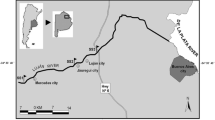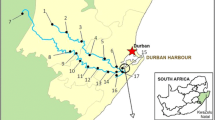Abstract
This paper analyzes how changes in hydrological conditions can affect the water quality of a temporary river that receives direct inputs of sewage effluents. Data from 12 spatial surveys of the Vène river were examined. Physico-chemical parameters, major ion, and nutrient concentrations were measured. Analyses of variance (ANOVA) and multivariate analyses were performed. ANOVA revealed significant spatial differences for conductivity and major ion but no significant spatial differences for nutrient concentrations even if higher average concentrations were observed at stations located downstream from sewage effluent discharge points. Significant temporal differences were observed among all the parameters. Karstic springs had a marked dilution effect on the direct disposal of sewage effluents. During high-flow periods, nutrient concentrations were high to moderate whereas nutrient concentrations ranged from moderate to bad at stations located downstream from the direct inputs of sewage effluents during low-flow periods. Principal component analysis showed that water quality parameters that explained the water quality of the Vène river were highly dependent on hydrological conditions. Cluster analysis showed that when the karstic springs were flowing, water quality was homogeneous all along the river, whereas when karstic springs were dry, water quality at the monitoring stations was more fragmented. These results underline the importance of considering hydrological conditions when monitoring the water quality of temporary rivers. In view of the pollution observed in the Vène river, “good water chemical status” can probably only be achieved by improving the management of sewage effluents during low-flow periods.





Similar content being viewed by others
References
Bengraïne, K., & Marhaba, T. F. (2003). Using principal component analysis to monitor spatial and temporal changes in water quality. Journal of Hazardous Materials, 100, 179–195.
Berenzen, N., Schulz, R., & Liess, M. (2001). Effects of chronic ammonium and nitrite contamination on the macroinvertebrate community in running water microcosms. Water Research, 35, 3478–3482.
Bu, H., Tan, X., Li, S., & Zhang, Q. (2010). Temporal and spatial variations of water quality in the Jinshui River of the South Qinling Mts., China. Ecotoxicology and Environment Safety, 73, 907–913.
David, A., Gomez, E., Aït-Aïssa, S., Rosain, D., Casellas, C., & Fenet, H. (2010). Impact of urban wastewater discharges on the sediments of a small Mediterranean river and associated coastal environment: assessment of estrogenic and dioxin-like activities. Archives of Environmental Contamination and Toxicology, 58, 562–575.
David, A., Perrin, J.-L., Rosain, D., Rodier, C., Picot, B., & Tournoud, M.-G. (2011). Implication of two in-stream processes in the fate of nutrients discharged by sewage effluents in a temporary river. Environmental Monitoring and Assessment, 181, 491–507.
Dixon, W., & Chiswell, B. (1996). Review of aquatic monitoring program design. Water Research, 30, 1935–1948.
Drolc, A., Koncan, J. Z., & Tisler, T. (2007). Evaluation of point and diffuse sources of nutrients in a river basin on base of monitoring data. Environmental Monitoring and Assessment, 129, 461–470.
Grillot, C. (2006). Fonctionnement hydrologique et dynamique des nutriments d’une rivière intermittente méditerranéenne en étiage et en crues. Analyse spatiale et temporelle. Thèse de Doctorat Thesis, Montpellier, 292 pp.
Hébrard, O., Pistre, S., Cheyneta, N., Dazya, J., Batiot-Guilhe, C., & Seidel, J.-L. (2003). Origin of the Languedoc-Roussillon’s chloride rich karstic spring waters. Comptes Rendus Geosciences, 338, 703–710.
Helena, B., Pardo, R., Vega, M., Barrado, E., Fernández, J. M., & Fernández, L. (2000). Temporal evolution of groundwater composition in an alluvial aquifer (Pisuerga river, Spain) by principal component analysis. Water Research, 34, 807–816.
Jackson, J. E. (1991). A user’s guide to principal components. New York: Wiley.
Jacobson, P. J., Jacobson, K. M., Angermeier, P. L., & Cherry, D. S. (2004). Variation in material transport and water chemistry along a large ephemeral river in the Namid Desert. Freshwater Biology, 44, 481–491.
James, D., Hanks, R., & Jurinak, J. (1982). Modern irrigated soils. New York: Wiley.
Jourde, H., Roesch, A., Guinot, V., & Bailly-Comte, V. (2007). Dynamics and contribution of karst groundwater to surface flow during Mediterranean flood. Environmental Geology, 51, 725–730.
Kazi, T. G., Arain, M. B., Jamali, M. K., Jalbani, N., Afridi, H. I., Sarfraz, R. A., Baig, J. A., & Shah, A. Q. (2009). Assessment of water quality of polluted lake using multivariate statistical techniques: a case study. Ecotoxicology and Environmental Safety, 72, 301–309.
Kemp, M. J., & Dodds, W. K. (2002). Comparisons of nitrification and denitrification in prairie and agriculturally influenced streams. Ecological Applications, 12, 998–1009.
Marti, E., Aumatell, J., Godé, L., Pocha, M., & Sabater, F. (2004). Nutrient retention efficiency in streams receiving inputs from waste-water treatment plants. Journal of Environmental Quality, 33, 285–293.
Meglen, R. R. (1992). Examining large databases: a chemometric approach using principal component analysis. Marine Chemistry, 39, 217–237.
Merseburger, G. C., Marti, E., & Sabater, F. (2005). Net changes in nutrient concentrations below a point source input in two streams draining catchments with contrasting land uses. Science of the Total Environment, 347, 217–229.
Nicolau, R., Galera-Cunha, A., & Lucas, Y. (2006). Transfer of nutrients and labile metals from the continent to the sea by a small Mediterranean river. Chemistry, 63, 469–476.
Obermann, M., Rosenwinkel, K. H., & Tournoud, M. G. (2009). Investigation of first-flushes in a medium-sized Mediterranean catchment. Journal of Hydrology, 373, 405–415.
Ouyang, Y., Nkedi-Kizza, P., Wu, Q. T., Shinde, D., & Huang, C. H. (2006). Assessment of seasonal variations in surface water quality. Water Research, 40, 3800–3810.
Perrin, J.-L., & Tournoud, M.-G. (2009). Hydrological processes controlling flow generation in a small Mediterranean catchment under karstic influence. Hydrological Sciences Journal, 54, 1125–1140.
Picot, B., Andrianarison, T., Olijnyk, D. P., Wang, X., Qiu, J. P., & Brissaud, F. (2009). Nitrogen removal in wastewater stabilisation ponds. Desalination and Water Treatment, 4, 103–110.
Sabater, F., Sabater, S., & Armengol, J. (1990). Chemical characteristics of a Mediterranean river as influenced by land uses in the watershed. Water Research, 24, 143–145.
Skoulikidis, N. (2008). Defining chemical status of a temporary Mediterranean River. Journal of Environmental Monitoring, 10, 842–852.
Skoulikidis, N., Amaxidis, Y., Bertahas, I., Laschou, S., & Gritzalis, K. (2006). Analysis of factors driving stream water composition and synthesis of management tools—a case study on small/medium Greek catchments. Science of the Total Environment, 362, 205–241.
Tournoud, M., Perrin, J., Gimbert, F., & Picot, B. (2005). Spatial evolution of nitrogen and phosphorus loads along a small Mediterranean river: implications of bed sediments. Hydrological Processes, 19, 3581–3592.
Vega, M., Pardo, R., Barrado, E., & Deban, L. (1998). Assessment of seasonal and polluting effects on the quality of river water by exploratory data analysis. Water Research, 32, 3581–3592.
Wahl, M. H., McKellar, H. N., & Williams, T. M. (1997). Patterns of nutrient loading in forested and urbanized coastal streams. Journal of Experimental Marine Biology and Ecology, 213, 111–131.
Acknowledgments
This study was funded by the European Commission, EESD Specific Program (tempQsim EVK-CT-2002-00112) and through the Mediterranean Intermittent River ManAGEment (MIRAGE project no. 211732, ref: FP7 ENV 2007 1, www.mirage-project.eu).
Author information
Authors and Affiliations
Corresponding authors
Rights and permissions
About this article
Cite this article
David, A., Tournoud, MG., Perrin, JL. et al. Spatial and temporal trends in water quality in a Mediterranean temporary river impacted by sewage effluents. Environ Monit Assess 185, 2517–2534 (2013). https://doi.org/10.1007/s10661-012-2728-4
Received:
Accepted:
Published:
Issue Date:
DOI: https://doi.org/10.1007/s10661-012-2728-4




